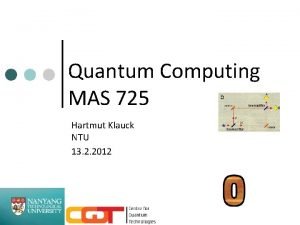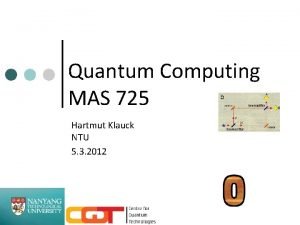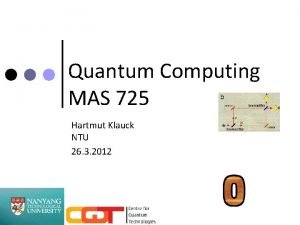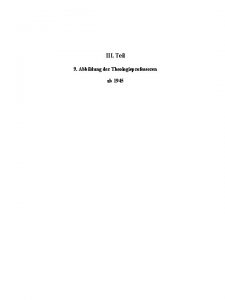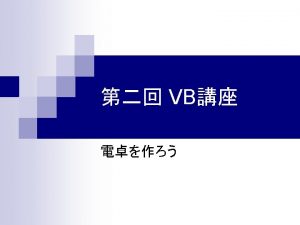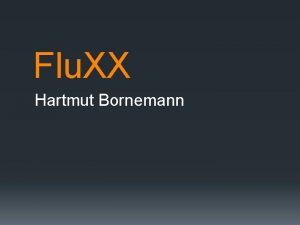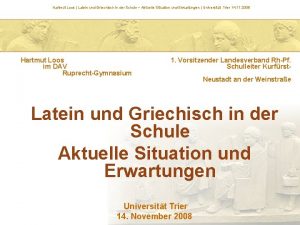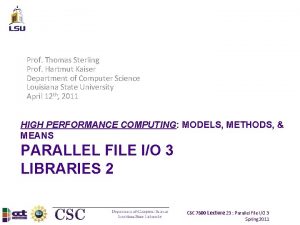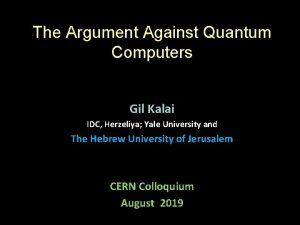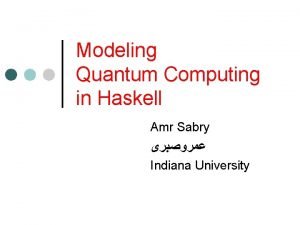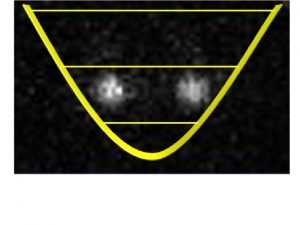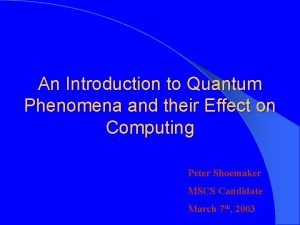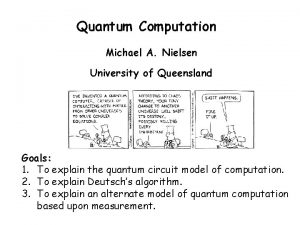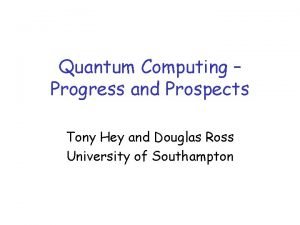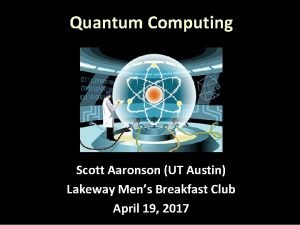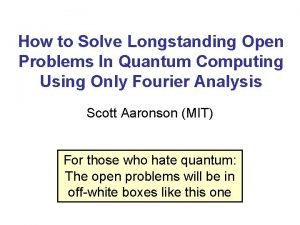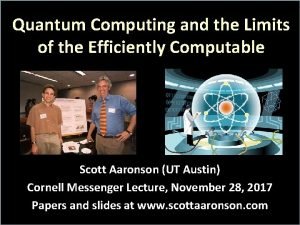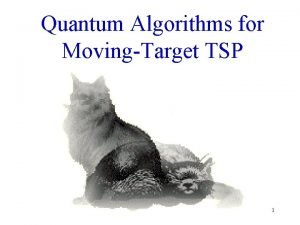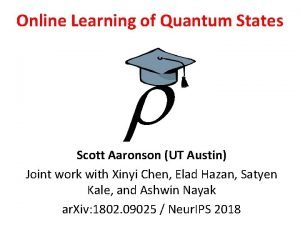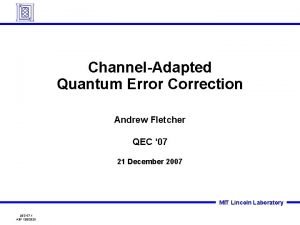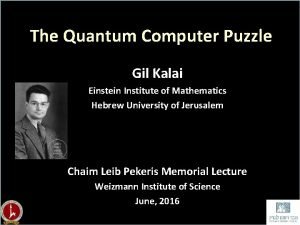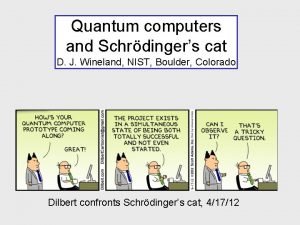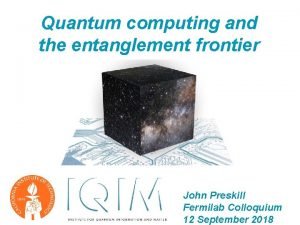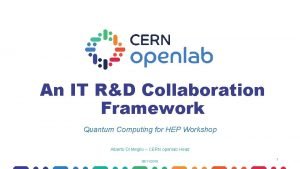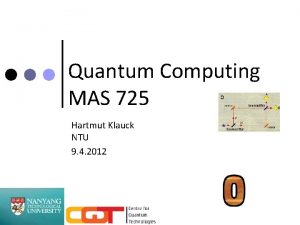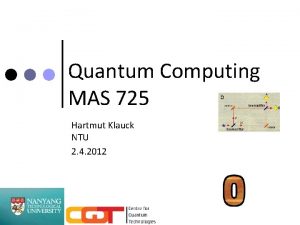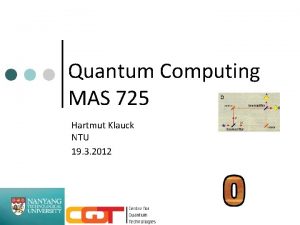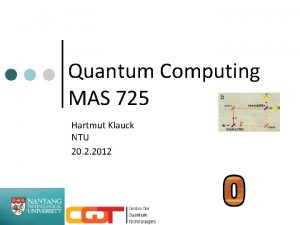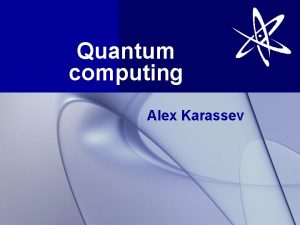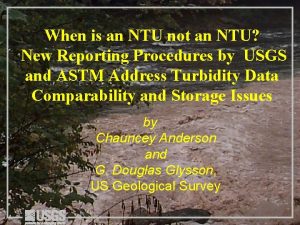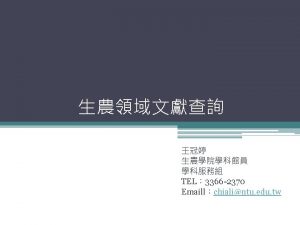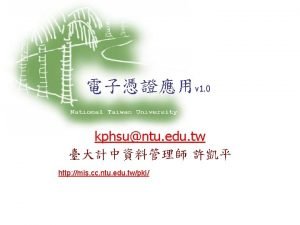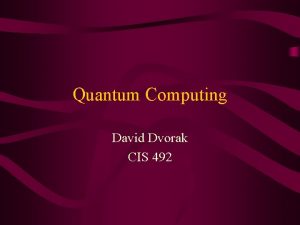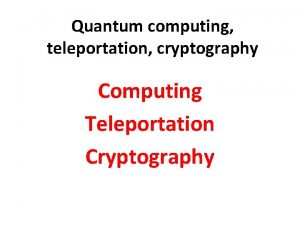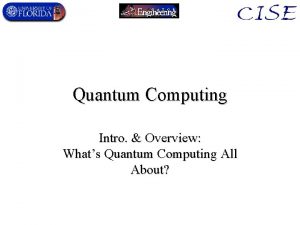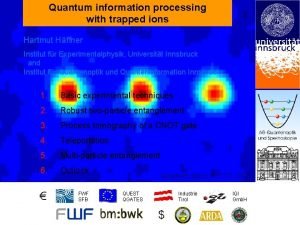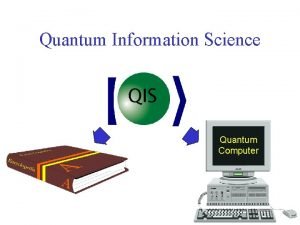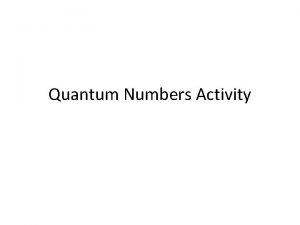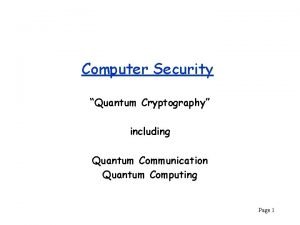Quantum Computing MAS 725 Hartmut Klauck NTU 12




![Superdense Coding ¢ ¢ ¢ [Bennett and Wiesner 92] Alice applies a unitary transformation Superdense Coding ¢ ¢ ¢ [Bennett and Wiesner 92] Alice applies a unitary transformation](https://slidetodoc.com/presentation_image_h2/b39999fa5217c5740fb7d330306a8dd3/image-5.jpg)






![Which features of quantum mechanics are „nonclassical“? ¢ ¢ [Einstein Podolsky Rosen 35] claimed Which features of quantum mechanics are „nonclassical“? ¢ ¢ [Einstein Podolsky Rosen 35] claimed](https://slidetodoc.com/presentation_image_h2/b39999fa5217c5740fb7d330306a8dd3/image-12.jpg)















- Slides: 27

Quantum Computing MAS 725 Hartmut Klauck NTU 12. 3. 2012

Topics today ¢ ¢ ¢ Superdense coding Distinguishing quantum states Bell inequalities

Superdense Coding ¢ ¢ ¢ Alice has two bits of classical information she wants to send to Bob We allow quantum communication Can we achieve this with sending one qubit (and using entanglement)?

Superdense Coding ¢ ¢ Communicate two bits without error: l Even when Alice and Bob share entanglement, sending 1 classical bit is not enough l Without entanglement Alice needs to send 2 qubits [Holevo 73] l Superdense Coding allows to send 2 bits with 1 qubit of communication and the consumption of 1 EPR pair Note the two bits to be communicated are not yet known when Alice and Bob exchange the EPR pair
![Superdense Coding Bennett and Wiesner 92 Alice applies a unitary transformation Superdense Coding ¢ ¢ ¢ [Bennett and Wiesner 92] Alice applies a unitary transformation](https://slidetodoc.com/presentation_image_h2/b39999fa5217c5740fb7d330306a8dd3/image-5.jpg)
Superdense Coding ¢ ¢ ¢ [Bennett and Wiesner 92] Alice applies a unitary transformation to her qubit xy=00 ) I (Identity) xy=01 ) Z (Phase Flip) xy=10 ) X (Bit Flip) xy=11 ) i¢Y Bit and Phase Flip

Superdense Coding ¢ The result is one of the four Bell states! ¢ xy=00: xy=01: xy=10: xy=11: ¢ ¢ ¢ 1/21/2 (|00 i+|11 i) 1/21/2 (|00 i-|11 i) 1/21/2 (|01 i+|10 i) 1/21/2 (|01 i-|10 i) Bob receives Alice’s qubit Since the states are mutually orthogonal for all 4 inputs, we can measure them and perfectly distinguish them Measure in the Bell basis

Superdense Coding ¢ Alternative: replace measuring in the Bell basis by: ¢ Apply the unitary operation that maps the Bell basis onto the standard basis For this simply reverse the circuit to generate Bell states Then measure in the standard basis ¢ ¢

A remark ¢ The superdense coding protocol is optimal: l Suppose Alice and Bob share an arbitrary entangled state (independent of the classical message they want to send) l They still have to send n/2 qubits to communicate n classical bits

Distinguishing quantum states ¢ ¢ ¢ We have a known set of quantum states S={ | 1 i , …, | ki } Input: a state from S Desired output: index i of the given state Identification Problem Suppose all states in S are pairwise orthogonal l We can solve the problem perfectly: construct an observable with subspaces Si=span(| ii), and projectors | iih i|

Distinguishing states that are not orthogonal ¢ ¢ ¢ Let S={ | i , | i } with h | i 0 Can we solve the indentification problem? | i = | i + | i with = h | i A projective measurement is linear, i. e. ” -proportion” of | i behaves just like | i With probability |h | i|2 the output on | i is (if the output on | i is always ) Hence the identification problem cannot be solved without error!

Which features of quantum mechanics are „nonclassical“? ¢ ¢ ¢ Classical physics is deterministic Example: Rolling a die l The reason we model this with probabilities is that we don‘t know the initial state of the die, and that computing the exact motions is hard Quantum mechanics is intrinsically probabilistic God does not play dice
![Which features of quantum mechanics are nonclassical Einstein Podolsky Rosen 35 claimed Which features of quantum mechanics are „nonclassical“? ¢ ¢ [Einstein Podolsky Rosen 35] claimed](https://slidetodoc.com/presentation_image_h2/b39999fa5217c5740fb7d330306a8dd3/image-12.jpg)
Which features of quantum mechanics are „nonclassical“? ¢ ¢ [Einstein Podolsky Rosen 35] claimed that quantum mechanics gives an incomplete picture of reality What does that mean? There might be a deeper „classical“ theory that allows to eliminate the probabilistic predictions of quantum mechanics by referring to „hidden parameters“ The state 1/21/2 (|00 i+|11 i) on two spatially separated qubits exhibits „spooky actions at a distance“: when measured it behaves like two perfectly correlated coin tosses, but (a large enough) distance would not allow communication

Quantum mechanics vs. local and realistic theories ¢ A theory is l local, when spatially separated systems do not influence each other l realistic, when properties are determined by the system that is measured already before a measurement • Properties can be predicted with certainty in principle • Properties are objective

Bell inequalities ¢ ¢ ¢ Charlie prepares two particles (in some state) and gives one to Alice and Bob each Alice and Bob are separated Alice‘s particle has properties for Alice PQ and PR with values Q and R Bob‘s particle has properties PS and PT with values S and T Values of the properties are „objective“, i. e. , are determined before the measurement takes place Q, R, S, T 2 {-1, 1}

Bell inequalities ¢ ¢ ¢ ¢ Rewrite QS+RS+RT-QT = Q( S-T ) + R( S+T ) S-T=0 or S+T=0, and QS+RS+RT-QT = § 2 We bound the expectation E[QS+RS+RT-QT] · 2 The random experiment here: Charlie‘s preparation of the particles There is no randomness after Charlie has prepared them Now we have probabilities P(q, r, s, t) of the event that the particles satisfy Q=q, R=r, S=s, T=t Expectation E[QS+RS+RT-QT] · 2 By linearity: E[QS]+E[RT]-E[QT] · 2

Bell inequalities ¢ Assumptions behind the inequality: There are probabilities P(q, r, s, t) [realism], and the measurements are independent [locality]

Measuring EPR pairs ¢ State of the two particles: 1/21/2 (|01 i-|10 i) ¢ We show that there are observables such that E[QS]+E[RT]-E[QT] ¸ 2¢ 21/2 ¢ Experimental test decides in favor of quantum mechanics [Aspect 82]

Hidden parameters ¢ ¢ We give a slightly different view of this result via games A classical model with hidden parameters: Alice and Bob receive particles prepared by Charlie l This means: l There is shared classical information, which determines the value for all measurements performed by Alice and Bob l Remark: given a realistic theory with hidden parameters such a list exists For the rest of the protocol/game Alice and Bob are separated (spatially and causally)

Hidden parameters ¢ ¢ ¢ The task of Alice and Bob: l Alice and Bob can initially agree on a strategy, then no further communication is allowed l Alice and Bob then receive a random bit x resp. Y l They may use more shared randomness l They produce outputs a, b l The protocol succeeds, if xÆy = a©b x, y describe the property that has to be measured What is the winning probability of the best protocol? Optimal strategy: both always output 0 They win with probability 3/4 If a locally realistic theory with hidden parameters can „explain“ quantum theory, then both theories need to predict the same outcome. I. e. , every quantum strategy needs to have success · ¾

A quantum protocol ¢ ¢ ¢ Alice and Bob share the state 1/21/2 (|01 i-|10 i) x=0, Alice measures in the standard basis and outputs the result x=1, Alice applies the rotation measures, outputs the result ¢ y=0, Bob measures, outputs the complement of the result ¢ y=1, Bob rotates with measures, outputs complement

Rotation gate Qubit |0 i is mapped to cos( /8) |0 i + sin( /8) |1 i Probability of measuring 0 is then cos 2( /8)

Analysis Case 1: x=0, y=0; both measure in the standard basis, output a, b with a=b, hence a©b=0, result is always correct ¢ Case 2: x=0, y=1; A) Alice measures a=0 (with prob. ½) Remaining state is |01 i Bob now has |1 i, i. e. , b=0 with prob. cos 2( /8), error is 1 -cos 2( /8)= sin 2( /8) B) Alice measures a=1, like case 2 a) ¢ Case 3: x=1, y=0; analogous , error sin 2( /8) ¢

Analysis ¢ ¢ ¢ Case 4: x=y=1, now the desired output is a©b=1 Alice and Bob both rotate before measuring Alice rotates by - /8, Bob rotates by + /8 Now the two measurements are independent (angle is ¼/4), and the error is ½ l A tedious calculation shows that the state after the rotations is ½ ( |00 i + |01 i - |10 i +|00 i ) Total error: ¼ (0 + 2¢sin 2( /8) + 1/2) ¼ 0. 2 Hence the success probability is larger than in any classical theory

Back to Bell inequality ¢ ¢ ¢ R: result of measuring in the standard basis (§ 1) Q: result of measuring after Alice’s rotation (§ 1) S: result of measuring in the standard basis (§ 1) T: result measuring after Bob’s rotation (§ 1) E[RS]=1, E[QS]=E[RT]=cos 2( /8) E[QT]=1/2 Hence E[RS]+E[QS]+E[RT]-E[QT]= 1 + 2 cos 2( /8) - 1/2 ¼ 2. 2 > 2

Was we know ¢ ¢ ¢ Quantum effects are fundamentally different from classical physics In toy problems (Deutsch Josza) quantum computers can beat classical computers Do we get speedups for interesting problems? Is it possible to solve NP-complete problems efficiently on quantum computers? How about uncomputable functions? ?

Goals of quantum computing ¢ ¢ ¢ (Building a quantum computer) Design efficient algorithms Design and analyze protocols for quantum communication/entanglement assisted communication Quantum cryptography Fault tolerance

Simon’s Problem ¢ ¢ ¢ ¢ Given: Black box function f: {0, 1}n!{0, 1}n Promise: there is an s 2{0, 1}n with s 0 n l For all x: f(x)=f(x©s) l For all x, y: x y©s ) f(x) f(y) Find s ! Example: f(x)=2 bx/2 c Then for all k: f(2 k)=f(2 k+1); s=00. . . 01 Simon’s algorithm solve the problem in time/queries poly(n) Every classical randomized algorithm (even with errors) needs (2 n/2) queries to the black box
 Hartmut klauck
Hartmut klauck Hartmut klauck
Hartmut klauck Ntu quantum computing
Ntu quantum computing Hans-josef klauck
Hans-josef klauck 649 en yakın onluğa yuvarlama
649 en yakın onluğa yuvarlama 1,151,725 bytes
1,151,725 bytes Quantum physics vs mechanics
Quantum physics vs mechanics Quantum physics vs mechanics
Quantum physics vs mechanics Hartmut bornemann
Hartmut bornemann Hartmut vöhringer
Hartmut vöhringer Hartmut loos
Hartmut loos Hartmut kaiser
Hartmut kaiser Gil kalai quantum computing
Gil kalai quantum computing Haskell quantum computing
Haskell quantum computing Quantum computing prerequisites
Quantum computing prerequisites Quantum computing meaning
Quantum computing meaning Nielsen quantum computing
Nielsen quantum computing Quantum computing: progress and prospects
Quantum computing: progress and prospects Quantum computing ut austin
Quantum computing ut austin Open problems in quantum computing
Open problems in quantum computing Ut austin quantum computing
Ut austin quantum computing Tsp quantum computing
Tsp quantum computing Ut austin quantum computing
Ut austin quantum computing Mit quantum computing
Mit quantum computing Gil kalai quantum
Gil kalai quantum Dilbert quantum computing
Dilbert quantum computing Quantum computing and the entanglement frontier
Quantum computing and the entanglement frontier Cern openlab quantum computing
Cern openlab quantum computing
